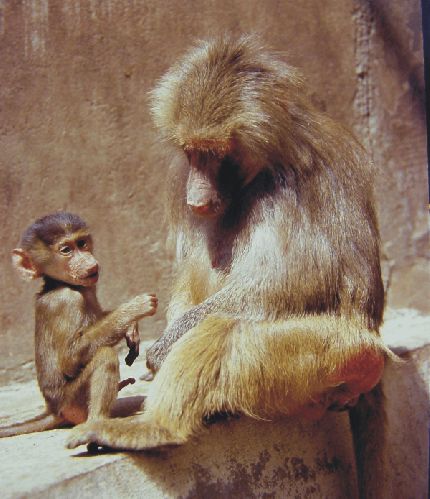

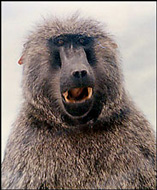 Anth 2140: Introduction to Archaeology
and Palaeoanthropology:
Humanity's Journeys
Anth 2140: Introduction to Archaeology
and Palaeoanthropology:
Humanity's Journeys
Tutorial notes, 26 October 2005
From the video, Baboon Tales:
Note - savannah habitat – presumed to be similar to initial hominid habitat
Similarities to human behaviour – and differences - what did you see?
Physical structures: ways that they moved:
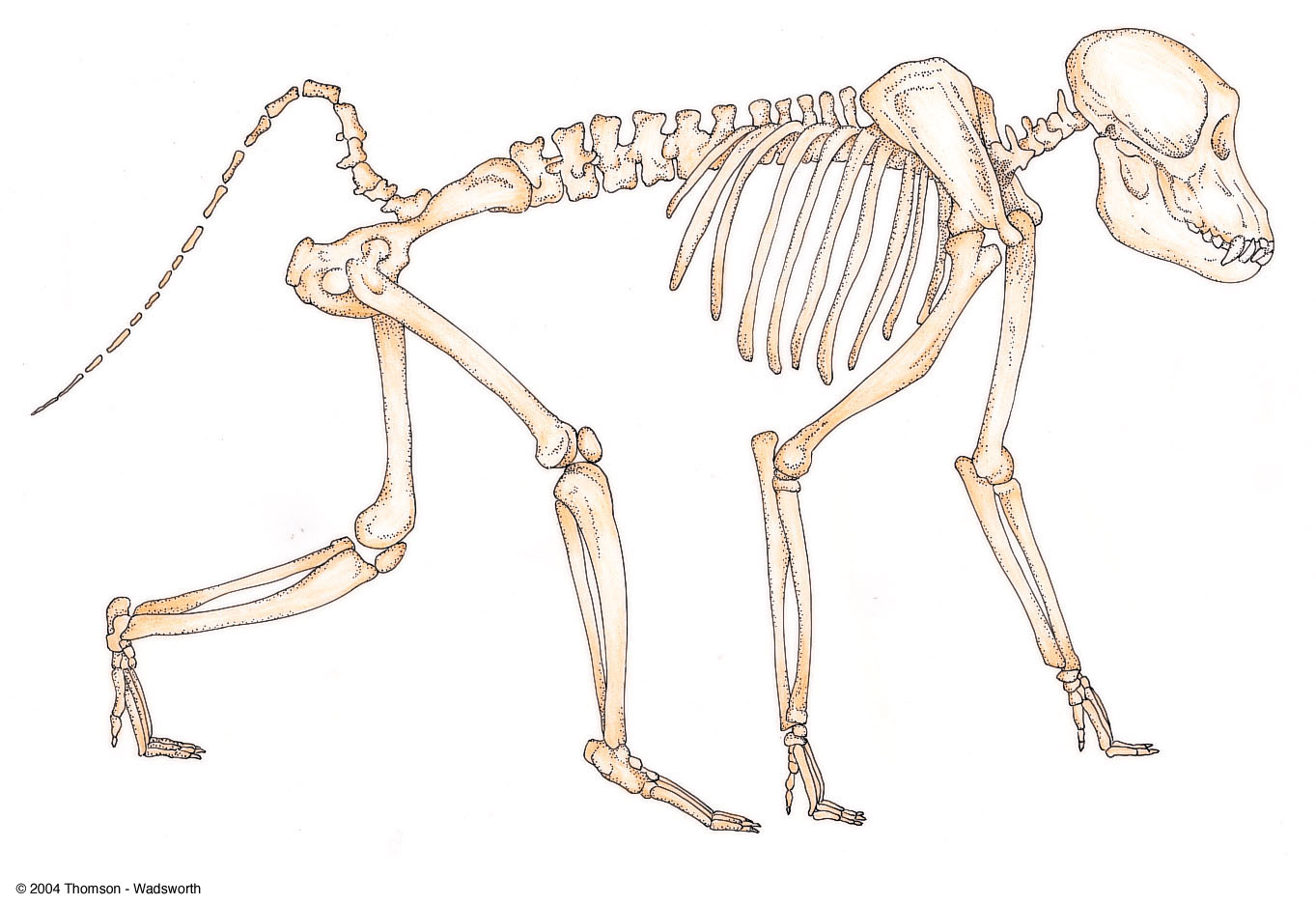 Terrestrial quadrupeds
- Front and hind limbs almost even length (forelimbs 90% of hind limb
length), fast runners. Food/environment: tend to live in savanna or open areas,
sit on the ground to eat seeds etc. Often tend to sleep in trees or on
cliffs to avoid predators. Usually live in large groups. Tail not prehensile.
Terrestrial quadrupeds
- Front and hind limbs almost even length (forelimbs 90% of hind limb
length), fast runners. Food/environment: tend to live in savanna or open areas,
sit on the ground to eat seeds etc. Often tend to sleep in trees or on
cliffs to avoid predators. Usually live in large groups. Tail not prehensile.
Physical differences in the baboons – especially sexual dimorphism, size differences
Anthropomorphism in language – is this appropriate? is there anything wrong with using emotional language to describe/interpret primate behaviour?
Amazingly close photography and audio recording... and yet, there is no sign of the primatologist here. This is a wild troop, but it has become accustomed to primatologists (Shirley Strum's team), which is how the cameras could get so close. But we should never forget that this is recorded from a human point of view, and edited by humans too. The observer may be invisible, but we are still seeing through his/her eyes.
Importance of Primate Behaviour Studies
Modern African apes and humans last shared a common ancestor between 5 and 8 m.y.a. We are closely related, and although the apes are not themselves frozen in time, they can shed light on early hominid behaviour, as well as modern human behaviour.
Modern humans are not the same as modern n-h primates, but we have some similarities worth exploring.
Ancient humans were not the same as modern n-h primates, but we have some similarities worth exploring.
n.b. most primate species are now threatened, many seriously so (Red List: http://www.iucnredlist.org/, http://www.iucnredlist.org/info/tables/table4a.html
n.b. this list shows trends... and our lack of knowledge
Nonhuman primate behaviour has been systematically studied since the early 20th century (captive baboons, London Zoo), but that was intermittent, and the first wild population studies came later, 1960s. (e.g. ape studies: Fossey, Goodall, Galdikas)
Many species, such as arboreal monkeys, have scarcely been studied at all.
n.b. many have been studied primarily in captivity, and this shapes their behaviour and our understanding of them (e.g. dominance hierarchies in baboons)
n.b. there are serious logistical challenges to some studies in the wild -- e.g. nocturnal, arboreal, very rare, etc. -- meaning that we don`t actually understand many primates very well yet!
n.b. there has also been a tendency to study primates for specific human agendas, rather than for themselves
What the class said in answer to the question: "What can we learn about human beings from nonhuman primates?"
Points highlighted in green are great! Points highlighted in blue (aggression and politics) and orange (sex & family) and pink (ancestors) and yellow (developmental) need to be unpacked and considered more fully.
* Ancestors and who we have evolved with, closest to us genetically / can learn how much we as human beings have evolved from the species of primates
* ways of communicating
* social systems: hierarchy (gender)
* human-specific characteristics
* anatomy of humans (brain, eyes)
* parenting and nursing styles, social behaviour
* territory and destruction, use of weapons
* culture transforming and not the same everywhere
* shared behaviours that are common between primates
* development of our emotions (anger/joy/greed/happiness)
* sexual behaviour, social behaviour (monogamy)
* the roots of male aggression/ aggressive nature of male primates parallel the tendency for male humans to become aggressive
* reconciliation
* to determine our origins and how we evolved
* interaction and bonding
* homosexuality -- against the argument that it's not natural (e.g. male apes with each other)
* going back to the roots of human evolution
* they use tools, they hunt
* how our social structure evolved
* what characteristics we owe to our primate ancestry and what characteristics are uniquely human
* social behaviours
* generational learning
* studying nonhuman primates allows us a better understanding of ourselves [but how? be specific]
* mate selection / monogamy
* social grouping - fornication - promiscuity
* teaching primates sign language to see if it can be taught generationally
* we can learn what we evolved from / we can learn where humans have come from / how prehistoric humans lived
* development of apes in behaviour is based on their tribal constructs also illustrates how children of human beings learn behaviour / human children and apes at same level
* apes can learn sign language which illustrates how we learned to communicate / learn how human's ability to talk developed
* can be used for scientific or psychological testing that would be unethical for human testing [many people consider primate research unethical too]
* shows a hierarchy of evolution
* by looking at the DNA we can see which traits were dominant, which were strong and survived [?]
* early human family structure
* communication, conflict resolution
* our social skills are somewhat similar
* we can learn why it is that we stand upright
* what our ancestors were like
* human political system is similar to the hierarchy of other primate systems
* study a gorilla today, see how we might have behaved
* learn how units of family and society were formed
* nonhuman primate behaviour has continuations in human behaviour, like breastfeeding and male dominance
* nonhuman primates kill, like we do / cannibalism
* aggression for procreation not necessary
* hierarchy in terms of gender does not dictate advantage
* nurturing is not necessarily a female trait
* we can learn from their mistakes [?]
* gender roles / sexual practices
* heterosexuality isn't natural and universal
* patriarchal society
* insight
into how our ancestors made tools
* learned behaviour
* dominant male
* high rank leads to high ranking offspring leads eventually to human
* reproduction, family structure
* the family unit consists of a nurturing mother and children and the social structure of hunter & gatherer (like the breadwinner of our social life)
*male dominance in the primate world - women have more independence but in the past mostly male dominated
*
Remember, learning how to approach a problem/question/subject is an important task here.
BE VERY CAREFUL OF 'shopping for evidence' to support our preconceptions about humans, particularly
- aggression
- gender roles
If you want to argue that humans are naturally and normally ______ (violent, peaceful, polygamous, monogamous, heterosexual, sexually diverse, whatever), then you could just compare them to whichever group of primates fits your preconception (e.g. chimps are more aggressive than bonobos, some monkeys are monogamous and others are polygamous, etc.) . This can be powerful rhetoric, but what have you proven about human nature? Nothing.
So we should study primate behaviour to understand the realm of possible ways to behave, and to gain indirect insight into our own primate nature, rather than to prove anything about humans.
Also Remember:
1) Variation! E.g., one baboon troop isn't just like any other. Just as the human species has culture and different societies, so do baboons. Different baboon groups have different customs and social patterns. (Similar to article about chimps in readings.)
2) The researcher! Different researchers can have vastly different perceptions and interpretations of the animals they study.
For example, with respect to baboons, we might contrast two well-known researchers:
| Solly Zuckerman | Shirley Strum |
| male observer | female observer |
| 1920s (and later) in London England | 1970s (and later) based in California |
| observed captive baboons in London Zoo | observed wild baboons in Africa |
| primarily saw dominance/hierarchy/aggressive behaviour, saw males as central to group | primarily saw affiliative behaviours, sociability, peacemaking, females as central |
Who's right?
They probably each have some valid points. However, Zuckerman's research has been largely dismissed now (it was one of the first scientific primate behaviour studies done), whereas Strum's is highly respected. The point usually made with Zuckerman is that he was seeing what he expected to see. He was a man working in English society, which was highly structured according to class and gender, right after a massive war. One might therefore expect him to emphasize male behaviour, hierarchy, and violence.
In addition, we have to recognize that captive animals behave very differently from wild animals -- this was not fully appreciated in Zuckerman's time.
PRIMATES IN RESEARCH
There is a long and often unpleasant history of people using other beings in research.... from other humans to animals... or justifying ill-treatment of them on the basis of their insensibility (the idea that they don't suffer as we would, therefore it is okay to harm them for research's sake).
Recent or current primate research has included:
medical (to learn about human diseases)
psychological (e.g. Harlow)
anthropological/linguistics (to learn about language capabilities)
space-military (in lieu of humans)
ethology (the only kind of research done for their primates' own sake)
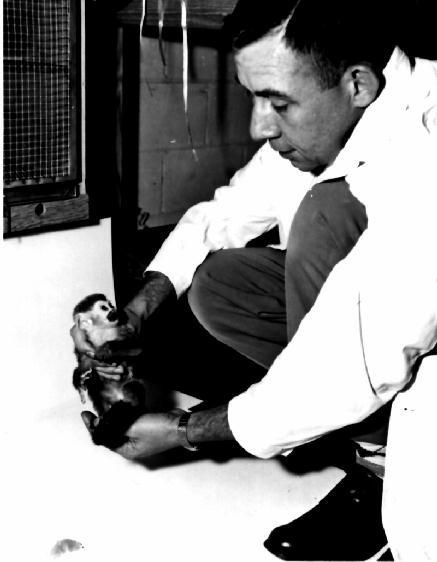 Example of
Primates in Research: The Space Race
Example of
Primates in Research: The Space Race
Animals, including monkeys, mice, dogs, cats, used often in early rocket experiments that didn't make it to 'space' altitude.
Laika the Russian dog, first (publicized) mammal in space, 3 Nov 1957. http://news.bbc.co.uk/1/hi/sci/tech/2367681.stm
NASA archive photos of primates used in space flight: http://pin.primate.wisc.edu/av/nasa1.html
Above: Gordo the squirrel monkey, first 'American' primate in space.... Jupiter AM-13 mission, 13 Dec 1958... lost at sea...
Sam the rhesus monkey, first 'American' primate in space that came home: Project Mercury, 4 Dec 1959. Image of Sam the rhesus monkey, after flight: http://images.jsc.nasa.gov/luceneweb/caption_direct.jsp?photoId=S63-19199
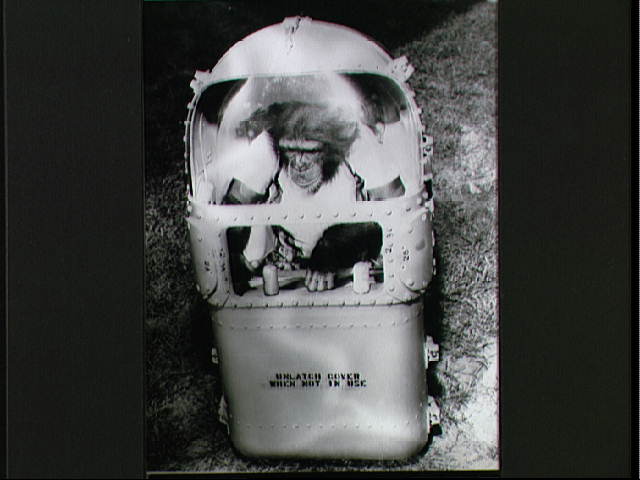 Ham
the chimpanzee, first 'American' ape in space, 31 Jan 1961.
Ham
the chimpanzee, first 'American' ape in space, 31 Jan 1961.
Right: Image of Ham (5 years old), after flight in Mercury-Redstone, 1961 http://images.jsc.nasa.gov/luceneweb/fullimage.jsp?photoId=S62-01698
Image of Ham receiving an apple, after recovery from Atlantic, after flight in Mercury-Redstone, 1961 http://images.jsc.nasa.gov/luceneweb/fullimage.jsp?photoId=S63-18198
Details of the Mercury-Redstone 2 Mission: http://www.hq.nasa.gov/office/pao/History/SP-4201/ch10-3.htm
Ham spent the rest of his life in zoos, and died in 1983.
Rescue efforts for the "surplus" NASA chimps -- it took a long time, but they are in sanctuaries now http://www.savethechimps.org/about_history.asp, http://www.savethechimps.org/about.asp, http://www.savethechimps.org/news/article_archives.asp
Yuri Gagarin was the first human in space, 12 April 1961.
Alan Shepard was the first American human in space, 5 May 1961
Other famous primates used in research:
Nim Chimpsky, used in language research as a young chimp, then was sold to a research lab, where he would have been used for hepatitis research: Animal rights activists campaigned for his freedom and won: http://www.fund.org/ranch/documentViewer.asp?ID=43, http://www.mcgill.ca/reporter/32/13/chimpsky/